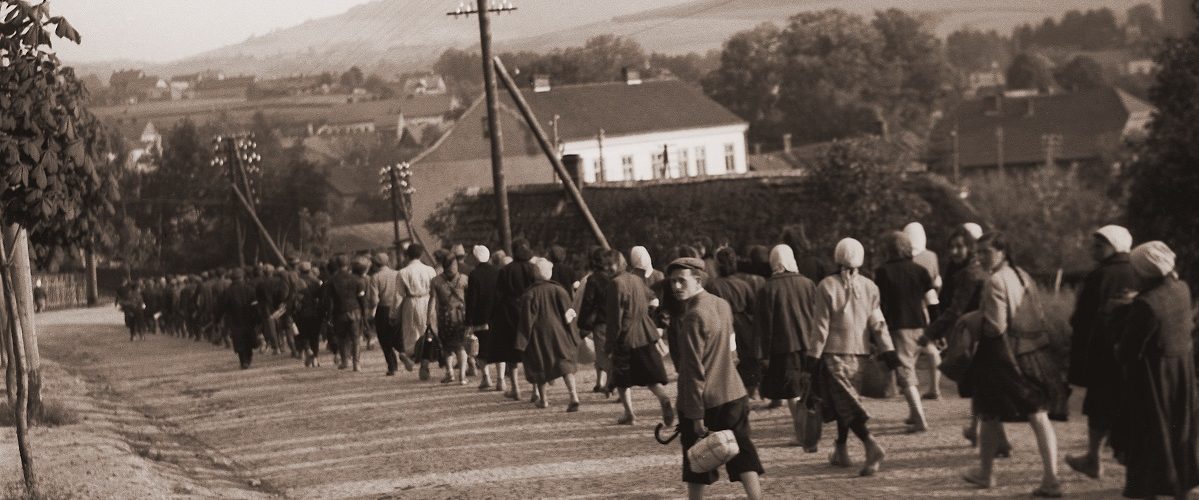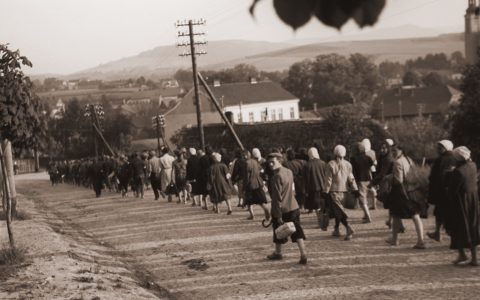In memory of the Jews of Limanowa
Passers-by!
You are standing in front of a „Memorial Stone” which honors Jewish residents of Limanowa, murdered by the German Nazis during the Holocaust.
In this distinctive place, on „Kamieniec„ where the Jewish ghetto existed during the German occupation, you are viewing, without a movement, a stone, a memorial, a symbol of suffering and death.
The path leading to the monument, was constructed from historic granite stones, upon which the Jews of Limanowa walked as they were hurried along by the Germans to the Jewish cemetery, where they were shot. The path was cut off before the stone, the same as the lives of the Jews were cut off. The square was covered with a stone (slag), which allows the observers to enter a mood of pensiveness and reflection.
Since 1942, there are no longer Jews in Limanowa. At that time, the German occupiers brutally destroyed the nearly 400 year old history of the Jewish community. Memory of Jewish Limanowa was lost with the death of the Jews. Yet, the Polish-Jewish Limanowa was our town. It was the town of Poles and Jews. Although, the relations between these two different ethnic groups were not always amicable, yet memory of Jewish heirtage cannot be obliterated from the town’s history.
The first record of a population of Jewish faith in Limanowa dates to1640, when the authorities eithdrew the lease of Izrael Izaakowicz to operate a taproom. Subsequent information from the middle of he 18th century pertains to Michal Rozanski, who converted from the Judaism to Catholicism. We have similar information from 1761, when a 17 year old Jewish young girl converted from to Catholicism accepting at her baptism the name Anna Marianna. In 1765, there were 21 Orthodox Jews. In the middle of the 19th century the Jewish commnity in Limanowa became independent.
In 1867, the Jewish Kahal, or Jewish community, was established in Limanowa which assumed authority over
all the Jewish persons who lived in the Limanowa district. At the beginning of the 19th century, two influential Jewish families settled in Limanowa. The Goldfinger and the Blaugrund families. In the middle of the century there were approximately 30 Jewish families in Limanowa. Their main source of income was commerce in grain, and lime imported from Podgorze near Krakow. They also traded in fur, and feathers sold at the local country fairs. A significant movement of Jews to Limanowa was connected with the construction of the Galician transversal train line, which resulted in an increase in the attractiveness of the town and the arrival of settlers both Christian and Jewish. Since there were increased employment opportunities, there were additional investments in Limanowa and surrounding areas which continued the growth of the town. Already in 1884, there were 880 Jewish residents in Limanowa.
Jewish society differed from the Polish society, in religion, authority and powers, attire, customs, and language. In Limanowa, like in other Galician towns, Jews spoke Yiddish at home. On the street, and in contacts with neighbors, they often spoke Polish.
In town, 50% of the Jewish inhabitants of Limanowa were Chasidic, whose occupations were in commerce. They had to go to the synagogue at least once per day. The next group were Orthodox Jews. They represented about 25% of the Jewish population. The rest of the Jewish population were artisans and clerks, who due to lack of time, showed up at the synagogue only on special festive religious occasions. In Limanowa there were three Jewish prayer houses.
By the end of the 19th century, there were 5 cheders (religious schools) in town, where young Jews could receive a Jewish education. Being closed off to the outside world was the main reason for the lack of traces for the existence of Jews in Limanowa.
There was no large scale intellectual circle which could have left a heritage in the form of diaries, newspapers, letters etc. A small group of intellectuals in Limanowa was comprised of persons who arrived from the outside world. One such person was the lawyer Jonasz (Jan) Hammerschlag. Another was the doctor Feniks Kohn. The first was not only a lawyer, but also served on the City Council. It’s worthwhile to add, that since the 1930’s, one third of the the City Council of Limanowa were Jews. Kohn arrived in Limanowa in the middle of the 1840’s and for the next 50 years worked as a physician, while at the same time, served as a councilman to the city. For his achievements, in 1886, he received the title of Honored Resident of the town.
In the town, despite the fact that almost 50% of residents were Jewish. aside from a few episodes, there were no antisemtic incidents. There were cases of cooperation with the Jews on various initiatives, such as the constrution of a place of worship in Limanowa. The Parish Priest of Limanowa at the time, asked the Jew Blech, to help him realize an order of tiles to build a church. Blech arranged the purchase in Vienna. Another example of productive collaboration between the priest Kazimierz Lazarski and the local diaspora was the presence and speech of a representative of the Jewish community at the 50 year celebration of the priest’s ministry.
During World War I, the Limanowa Jews were among those most victimized due to the loss of their property and assets. In the reports of the Administrative District, National Committee, we can find information pertaining to the out migration of the Jews from their native town. Everyone was so afraid of the arrival of the Tzar’s army. It was in Russia, during the XIX century, that Jews experienced the worst pogroms against their population. Therefore, when there was a specter over Limanowa that it might be taken by Moscovites, the Jews boarded and sealed their shops and left the town.
Unfortunately, these actions did not protect their possessions from theft and destruction by the Russians. Based on the information and the Universal List of the Second Polish Republic
in Limanowa as of 30 September 1921, lived 2143 residents, 1233 were of the Roman-Catholic faith, 5 were Greek-Catholic, and 905 were of the Jewish faith. However, according to the census of 1931, in Limanowa there were 1002 persons of Jewish ethnicity.
The Poles and the Jews bonded through art. The Bohemian circle of artists was created by both groups, who together appeared in the Jewish theatre in town, or when they jointly participated in musical groups and organized concerts.
The relationship between Jews and Poles during the interwar era did not undergo major changes. There was a distance between both groups, although one noticed some changes especially on the part of the Jews. They definitely became more open to Polish society, as compared with the Galician period. During this time, one of the most respected residents of the town was Rabbi Chaim Teitelbaum, who enjoyed the esteem of not only the Jewish community but also of the Christian residents of the town. Catholic residents went to him to resolve problems with Jewish residents. Generally, it was said that his decisions were just.
——————————————————————–
There are many reasons to learn about the Holocaust and to teach about it. But, the most important thing is not to allow it to happen again.
Ronbald H. Balson
The extermination of the Jews of Limanowa
Nazi policy of the IIIrd Reich was unique in its brutality and ruthlessness.
It especially impacted the Jewish population, which from the beginning of the occupation, was tormented by a series of restrictions, and was subjected to unusual repressions.
As in all other territories occupied by the Germans, in Limanowa the Jews were stripped of all human rights. The humiliations to which the Jews were subjected were both psychological and physical, and went hand in hand with numerous occasions of physical elimination, as proven by the first execution in Limanowa after the occupation of the those who enjoyed the highest authority as representatives of the Jewish community in town.
They were murdered together with one Catholic person in Cieniawa in Mordarka.
On March 15, 1940, a transport of 1000 persons arrived in Limanowa from Lodz. The transport consisted of 300 Poles and 700 Jews. They were housed at the site of the oil refinery in Sowliny in the buildings which previously housed the factory workers. The Poles obatined passes and left the camp. They were able to take the train in various directions of the country. The Jews remained alone. In the first days, about 300 persons were sent to other towns. 400 persons remained, including 170 children. Around the building where the Jews were housed, the authorities constructed a barbed wire fence with a locked gate. The Jews were watched by a policeman. The social and hygenic conditions in the camp were terrible. There were no basic medications. Attempts to free the prisoners from the camp met with difficulties. After 4 weeks, and strong petitions, 60 persons were able to leave legally. Many others, after fruitless wait to leave, and join their families, decided to escape. Therefore, after camp was in existence for 6 weeks, only 80 persons remained there. Several reports and petitions demonstrate the desperate and tragic situation, of the Jewish population during the Nazi occupation, as evidenced by the report sent by the Jewish Council in Limanowa in 1940 to the American „Joint Distributoin Committe” in Krakow. Here are two fragments from documents dated May 21, 1940,as well as October 30, 1940.
.
(…) Our town, as evidenced by pre war reports, belonged to the most impoverished in the District of Krakow. Nearly everyone was in trade, which currently is forbidden to the Jews in Limanowa. None of the Jewish businesses is functioning. This fact shows the level of poverty which is prevalent among the people, who for more than eight months have been deprived of any possibility for earning money. If the Jews of Limanowa do not quickly receive assistance from the outside, then they will certainly perish from starvation. In this situation, we are begging for your help as soon as possible.
(…) After many difficulties, we were able to start a kitchen for the poor children aged two to twelve. The kitchen is operational 3 times per week. We provide an afternoon snack, in the form of 200 grams of bread, and a small cup of coffee or tea with sugar. The bread is without fat. For now we are able to feed 120 of the poorest children, but we are unable to serve another 200 children. Currently we also need to serve 50 elderly persons who have no caregivers and no means. (Signed, Aron Lustig, President of the Judenrat – Jewish Council of Limanowa.
—————————————————————-
From these two documents it is clear how radically changed the status of the Jewish inhabitants during the Nazi occupation. All sources of income were confiscated: stores, shops of craftsmen, manufacturing plants, etc. This led to poverty and even starvation. More and more executions of the Jewish population in Limanowa became a daily event. In 1941, in Stara Wieś, in the „Pozary” hamlet 167 persons were shot, mainly the old and the sick. On May 7, 1941, as retaliation for the escape of two Jews, who were among a group of men being led by the SS, Bruno Baumack shot 12 young Jewish girls at the Jewish cemetery. In July 1941, several dozen persons were shot by a wall on
„Kamieniec” at today’s Jana Kilinskiego Street. In June 1942, the Nazis formed a ghetto in Limanowa. Nearly 2000 Jews were moved there from the town and surrounding villages. Under the threat of severe punishment, the Poles were forbidden from all contact with the Jews.
Initially, some stores functioned in the ghetto, but they were quickly closed due to lack of provisions. A terrible hunger befell the ghetto. The Nazis demanded a series of contributions from the Jews. Many from the Christian population of Limanowa attempted to help the Jews, by throwing bread,vegetables, and fruit unto the terrain of the ghetto. The ghetto on the „Kamieniec” was an open territory, but leaving the ghetto was threatened with death. The borders of the ghetto were today’s priest Ludwika Kowalskiego street, from Zielona Street to the Maly Rynek square. The border also ran along the buttresses of the square then „Sokół” and today market place, until the bridge on Targowa street. The border continued along the coast of the Mordarka stream to what was once a park, but is today an Elementary School.
Three pre WWII buildings, which were in the area of the ghetto, survive until today. The first, is an old tannery, which today serves as the Municipal Center for Social Services. In front of this building was placed the
Memorial Stone.
The second wooden building is located above the wall, at Jan Kilinskiego Street, during the war it was Rzeczna Street. Jews were shot under this wall. The third wooden building is located near the old sports fields „Sokół” now next to Targowy square.
In 1942, the Nazis implemented the policy for the systematic murder of Jews. Within the General Government, this plan received the name of
„Reinhardt” action. In order to carry out the plan, three extermination centers were built: Belzec, Sobibor and Treblinka. The „Reinhardt” action was a part of he bloodiest stage of the Nazi plans to exterminate the Jewish population.
The liquidation of the ghetto occured on August 18, 1942. This action was personally supervised and led by Heinrich Hamann, Chief of the Nowy Sacz Gestapo. Early in the morning, all residents of the ghetto were ordered to arrive at the Targowica, (at the time the place for animaltrade, today the area for bus stops). There, a selection was performed and the Jews divided into three groups. The first group, around 120 young men, were separated and sent to the work camp in Sowliny, where they were employed in the firm „Vianowa” to build roads. After three months, everyone in this group was shot at the Przylaski, on the road, in the direction from Limanowa to Tymbark.
During the selection on August 18, about 250 elderly persons, the sick and children, were taken to Stara Wieś and killed in the same spot of the previous execution on „Pozary.” The rest of the people, several hundred, were hurried in the direction of Nowy Sacz. Most of them were transported by train, between August 23 and August 28 to Belzec, where they perished in the death chambers. This is how the fate of the Limanowa Jews tragically ended, those who for nearly 400 years were part of the Limanowa community of our town. One can only imagine how the Jewish people affectionately said goodbye to the town, their homes and places of work, as well as to the memories of all that they had experienced there. The town was depopulated. Almost half of the town’s population suddently ceased to exist.
„Then, (before the war, when I still had family)
– I did not know, how happy I was.”
Barbara Engelking – from the publication „You also have to know how to die.”
Archival photos are from the album” „Crumbs of memory – Limanowa
on old photos.”
Description of the photographs:
1st Board
- A group of Jews from Limanowa at an excavation site – 1930’s.
- Jews from Limanowa at a funeral procession.
- Representatives of Limanowa waiting for the arrival of the President of the Republic Ignacy Moscicki – July 1929.
- Hanna Sandecer in the garden. In the background, on the right, the building of the browar (brewery) Marsów.
- Podhalanski Jewish Theatre in Limanowa – 1930.
2nd Board
- Jews working at the Limanowa market square – 1940’s.
.
- A column of Jews on Krakowska street (today the street of Jan Pawel II), rushing to the ghetto – 1942.
- Jews in the transit camp in Sowliny, who lived there from August 1942. Shot in
Przylaski
- Transport to the Jewish Cemetery of Jews to be shortly shot by the Germans – 1941.
- A memorial inscription at the Belzec Death Camp to commemorate the murdered residents of Limanowa


